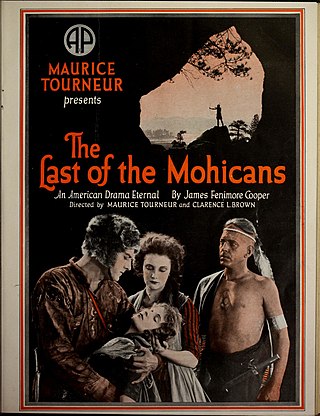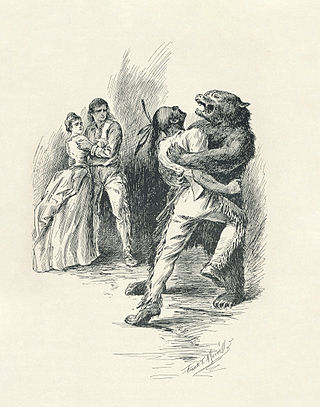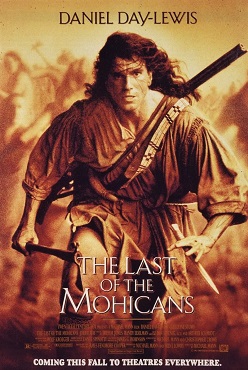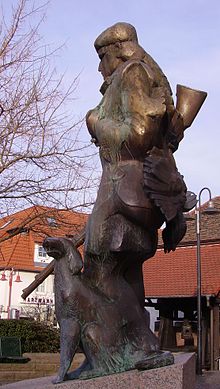
The Last of the Mohicans is a 1920 American silent adventure drama film written by Robert A. Dillon, adapted from James Fenimore Cooper's 1826 novel of the same name. Clarence Brown and Maurice Tourneur co-directed the film. It is a story of two English sisters meeting danger on the frontier of the American colonies, in and around the fort commanded by their father. The adventure film stars Wallace Beery, Barbara Bedford, Lillian Hall, Alan Roscoe and Boris Karloff in one of his earliest silent film roles. Barbara Bedford later married her co-star in the film, Alan Roscoe in real life. The production was shot near Big Bear Lake and in Yosemite Valley.

James Fenimore Cooper was an American writer of the first half of the 19th century, whose historical romances depicting colonial and indigenous characters from the 17th to the 19th centuries brought him fame and fortune. He lived much of his boyhood and the last fifteen years of life in Cooperstown, New York, which was founded by his father William Cooper on property that he owned. Cooper became a member of the Episcopal Church shortly before his death and contributed generously to it. He attended Yale University for three years, where he was a member of the Linonian Society.

The Last of the Mohicans: A Narrative of 1757 is an historical romance novel written by James Fenimore Cooper in 1826.

Magua is a fictional character and the main antagonist in the 1826 novel The Last of the Mohicans by James Fenimore Cooper. This historical novel is set at the time of the French and Indian War. A Huron Indian chief, he is also known by the French alias "Le Renard Subtil".

The Leatherstocking Tales is a series of five novels by American writer James Fenimore Cooper, set in the eighteenth-century era of development in the primarily former Iroquois areas in central New York. Each novel features Natty Bumppo, a frontiersman known to European-American settlers as "Leatherstocking", "The Pathfinder", and "the trapper". Native Americans call him "Deerslayer", "La Longue Carabine", and "Hawkeye".

The Pioneers, or The Sources of the Susquehanna; a Descriptive Tale is a historical novel by American writer James Fenimore Cooper. It was the first of five novels published which became known as the Leatherstocking Tales. Published in 1823, The Pioneers is the fourth novel in terms of the chronology of the novels' plots.

Chingachgook is a fictional character in four of James Fenimore Cooper's five Leatherstocking Tales, including his 1826 novel The Last of the Mohicans. Chingachgook was a lone Mohican chief and companion of the series' hero, Natty Bumppo. In The Deerslayer, Chingachgook married Wah-ta-Wah, who bore him a son named Uncas, but died while she was still young. Uncas, who was at his birth "last of the Mohicans", grew to manhood but was killed in a battle with the Huron warrior Magua. Chingachgook died as an old man in the novel The Pioneers, which makes him the actual "last of the Mohicans," having outlived his son.

The Last of the Mohicans is a 1992 American epic historical drama directed by Michael Mann, who co-wrote the screenplay with Christopher Crowe, based on the 1826 novel of the same name by James Fenimore Cooper and its 1936 film adaptation. The film is set in 1757 during the French and Indian War. It stars Daniel Day-Lewis, Madeleine Stowe, and Jodhi May.

The capture and rescue of Jemima Boone and the Callaway girls is a famous incident in the colonial history of Kentucky. Three girls were captured by a Cherokee-Shawnee raiding party on July 14, 1776 and rescued three days later by Daniel Boone and his party, celebrated for their success. The incident was portrayed in 19th-century literature and paintings: James Fenimore Cooper created a fictionalized version of the episode in his novel The Last of the Mohicans (1826) and Charles Ferdinand Wimar painted The Abduction of Boone's Daughter by the Indians.

The Deerslayer, or The First War-Path (1841) was James Fenimore Cooper's last novel in his Leatherstocking Tales. Its 1740–1745 time period makes it the first installment chronologically and in the lifetime of the hero of the Leatherstocking tales, Natty Bumppo. The novel's setting on Otsego Lake in central, upstate New York, is the same as that of The Pioneers, the first of the Leatherstocking Tales to be published (1823). The Deerslayer is considered to be the prequel to the rest of the series. Fenimore Cooper begins his work by relating the astonishing advance of civilization in New York State, which is the setting of four of his five Leatherstocking Tales.

The Last of the Mohicans is a 1932 American pre-Code Mascot movie serial based on the 1826 novel The Last of the Mohicans by James Fenimore Cooper.

The Pathfinder, or The Inland Sea is a historical novel by American author James Fenimore Cooper, first published in 1840. It is the fourth novel Cooper wrote featuring Natty Bumppo, his fictitious frontier hero, and the third chronological episode of the Leatherstocking Tales. The inland sea of the title is Lake Ontario.

The Prairie: A Tale (1827) is a novel by James Fenimore Cooper, the third novel written by him featuring Natty Bumppo. His fictitious frontier hero Bumppo is never called by his name, but is instead referred to as "the trapper" or "the old man". Chronologically The Prairie is the fifth and final installment of the Leatherstocking Tales, though it was published before The Pathfinder (1840) and The Deerslayer (1841). It depicts Natty in the final year of his life, still proving helpful to people in distress on the American frontier. The book frequently references characters and events from the two books previously published in the Leatherstocking Tales as well as the two which Cooper would not write for more than ten years. Continuity with The Last of the Mohicans is indicated by the appearance of the grandson of Duncan and Alice Heyward, as well as the noble Pawnee chief Hard Heart, whose name is English for the French nickname for the Delaware, le Coeur-dur.

The Last of the Mohicans is a 1936 American Western film directed by George B. Seitz from a screenplay by Philip Dunne, based on the 1826 novel of the same name by James Fenimore Cooper. The film stars Randolph Scott, Binnie Barnes, and Henry Wilcoxon.
The Deerslayer and Chingachgook is the feature-length first part of the two-part 1920 German silent Western film Lederstrumpf (Leatherstocking), directed by Arthur Wellin and featuring Bela Lugosi. It is based on the 1841 novel The Deerslayer by James Fenimore Cooper. The second part is called The Last of the Mohicans.
The Last of the Mohicans is the feature-length second part of the 1920 German silent Western film Lederstrumpf (Leatherstocking) directed by Arthur Wellin and featuring Bela Lugosi and Emil Mamalock. It is based on James Fenimore Cooper's 1826 novel of the same name. The first part is The Deerslayer and Chingachgook. A print of Lederstrumpf, in its heavily edited shortened U.S. version titled The Deerslayer, was discovered in the 1990s, but the original full-length German film is lost. Bela Lugosi played the Indian Chingachgook, one of his most unusual roles, and Emil Mamalock played Hawkeye, the Deerslayer.
The Last of the Mohicans is a 1971 BBC serial, based on the 1826 novel of the same name by James Fenimore Cooper, directed by David Maloney.

Hawkeye is a television series, airing in syndication for one season during 1994–1995, and produced by Stephen J. Cannell. The series was filmed in North Vancouver and Vancouver, British Columbia, Canada.
The Last of the Mohicans is a 1968 internationally co-produced Western film, co-directed by Jean Dréville, Pierre Gaspard-Huit and Sergiu Nicolaescu. It was the second episode of the European TV miniseries Leatherstocking Tales.
















